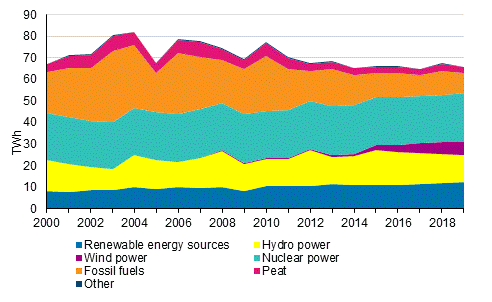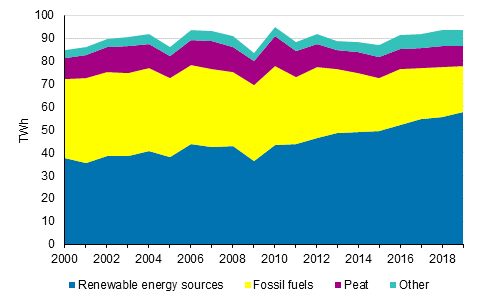Published: 3 November 2020
More district heat was produced with renewable fuels than with fossil fuels for the first time in 2019
Contact information was updated on 19 November 2020. The second person providing further information was removed.
In 2019, the production of district heat in Finland amounted to 38.1 TWh, of which 15.3 TWh were produced with renewable fuels, 13.2 TWh with fossil fuels, 5.7 TWh with peat and 4.0 TWh with other energy sources. The production of electricity in Finland amounted to 66.0 TWh in 2019, which is 1.5 TWh less than in the year before. The share of electricity produced with fossil-free energy sources – renewable energy sources and nuclear power – was 82 per cent, which is three percentage points higher than in 2018. Industrial heat production amounted to 55.4 TWh, which is on level with 2018. The majority of industrial heat, around 75 per cent, was produced with domestic wood-based fuels.
These data derive from the statistics on the production of electricity and heat compiled by Statistics Finland.
Electricity generation by energy source 2000-2019

In 2019, the production of electricity in Finland amounted to 66.0 terawatt hours (TWh) or one billion kilowatt hours (kWh). Production decreased by 1.5 TWh from the previous year. Correspondingly, total consumption of electricity decreased by 1.4 TWh, amounting to 86.1 TWh in 2019. Of total electricity consumption, 77 per cent was covered by domestic production and 23 per cent by net imports of electricity from the Nordic countries, Russia and Estonia. Net imports of electricity remained on level with the previous year at around 20 TWh.
The volume of electricity produced with renewable energy sources amounted to 31 TWh. Renewable energy sources accounted for 47 per cent of electricity production. Of the electricity produced with renewable energy sources 40 per cent was produced with hydro power, 19 per cent with wind power and almost all the rest with wood-based fuels. Thirty-five per cent of electricity was produced with nuclear power, 14 per cent with fossil fuels and four per cent with peat.
The share of hydro power in electricity production varies yearly according to the water situation. The electricity produced by hydro power amounted to 12.2 TWh, which is clearly less than in the year before. For this reason, the amount of electricity produced with renewable energy sources decreased slightly in 2019 despite the fact that slightly more electricity was produced with renewable fuels and wind power than in 2018. The production of solar electricity grew clearly but its share of the total electricity production is still marginal (0.2%).
The amount of electricity produced with fossil fuels decreased by 16 per cent and that of electricity produced with peat by 13 per cent from the previous year. The amount of electricity produced with hard coal decreased by as much as 24 per cent. The amount of electricity produced with natural gas decreased slightly less, by around eight per cent.
In 2019, the production of electricity with renewable fuels amounted to 12.5 TWh, of which 6.8 TWh were produced with black liquor and 5.1 TWh with other wood-based fuels. Correspondingly, 11.9 TWh of electricity was produced with fossil fuels and peat, which is 2.2 TWh less than in 2018. Thus, the decrease of 1.5 TWh in total electricity production from 2018 was entirely directed to fossil fuels and peat, as the production of nuclear power increased by one TWh and the production of renewable electricity remained almost on level with 2018.
Electricity and heat production by production mode in 2019
| Electricity, GWh | District heat, GWh | Industrial heat, GWh | Fuels used, TJ 1) | |
| Separate production of electricity | ||||
| - Hydro power | 12 239 | .. | .. | .. |
| - Wind power | 6 025 | .. | .. | .. |
| - Solar power | 147 | .. | .. | .. |
| - Nuclear power | 22 915 | .. | .. | .. |
| - Condensing power 2) | 3 142 | .. | .. | 34 842 |
| - Total | 44 467 | .. | .. | 34 842 |
| Combined heat and power production | 21 576 | 24 022 | 43 397 | 392 446 |
| Separate heat production | .. | 14 120 | 12 007 | 93 489 |
| Total production | 66 043 | 38 142 | 55 404 | 520 777 |
| Net imports of electricity | 20 042 | .. | .. | .. |
| Total | 86 085 | 38 142 | 55 404 | 520 777 |
2) Condensing power includes condensing power plants, shares of condensing electricity of combined heat and power production plants, and peak gas turbines and similar separate electricity production plants.
The production of district heat totalled 38.1 TWh in 2019, being one per cent lower than in the previous year. The use of fossil fuels in the production of district heat decreased by 14 per cent and that of peat by nine per cent from the previous year. Clearly under one-half of district heat was produced with fossil fuels. Most of district heat was produced with wood fuels (35 %) and hard coal (18 %). Peat retained its position as the third most important energy source in district heat production; 15 per cent of district heat was produced with peat.
The amount of district heat produced with flue gas scrubbers and other waste heat (includes heat pumps) has grown clearly in recent years. They produced 10 per cent of district heat in 2019.
The production of industrial heat was 55.4 TWh in 2019. Production went up 0.4 per cent from the year before. Fifty-three per cent of heat produced for the needs of manufacturing comes from black liquor. In all, more than three-quarters of the production of industrial heat was based on renewable fuels. One of the biggest users of industrial heat is the forest industry, which uses its own fuels, like black liquor and other wood fuels, in production. In the chemical, forest and metal industries, part of the use of heat is considered as direct fuel use in the statistics and is thus not visible in the production figures on industrial heat.
District heat and industrial heat production by fuels 2000-2019

The statistics on the production of electricity and heat cover the entire production of electricity connected to the grid. The coverage of the statistics has been improved by adding district heat production plants. Therefore, the figures are not fully comparable with the statistics for previous years. Solar power and small CHP produced with biogas are also included in the statistics. From 2015 onwards, the statistics also cover small heat plants, that is, all production of district heat. The statistics do not cover all industrial heat and producers of so-called local heating.
Links
Statistics Finland's electricity and heat production inquiry
Finnish Energy, electricity production statistics https://energia.fi/en/statistics
Source: Statistics on production of electricity and heat, Statistics Finland and Electricity statistics, Finnish Energy Industries
Inquiries: Minna Niininen 029 551 3549, energia@stat.fi
Head of Department in charge: Mari Ylä-Jarkko
Publication in pdf-format (359.5 kB)
- Tables
-
Tables in databases
Pick the data you need into tables, view the data as graphs, or download the data for your use.
Appendix tables
- Figures
-
- Appendix figure 1. Electricity generation by energy source 2019 (3.11.2020)
- Appendix figure 2. Electricity generation with renewables 2019 (3.11.2020)
- Appendix figure 3. Electricity generation by production mode 2000-2019 (3.11.2020)
- Appendix figure 4. Electricity generation with renewables 2000-2019 (3.11.2020)
- Appendix figure 5. District heat production by fuels 2000-2019 (3.11.2020)
- Appendix figure 6. Industrial heat production by fuels 2000-2019 (3.11.2020)
- Appendix figure 7. Fuel use in separate electricity production 2018-2019 (3.11.2020)
- Appendix figure 8. Fuel use in combined heat and power production 2018-2019 (3.11.2020)
- Appendix figure 9. Fuel use in separate heat production 2018-2019 (3.11.2020)
Updated 3.11.2020
Official Statistics of Finland (OSF):
Production of electricity and heat [e-publication].
ISSN=1798-5099. 2019. Helsinki: Statistics Finland [referred: 23.12.2025].
Access method: http://stat.fi/til/salatuo/2019/salatuo_2019_2020-11-03_tie_001_en.html

